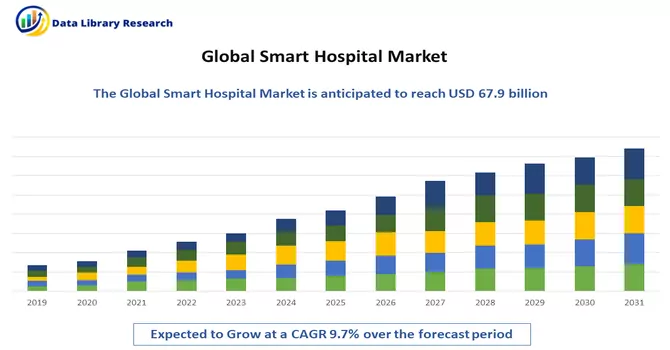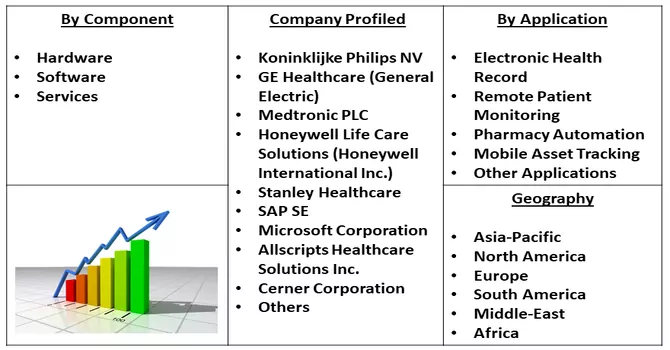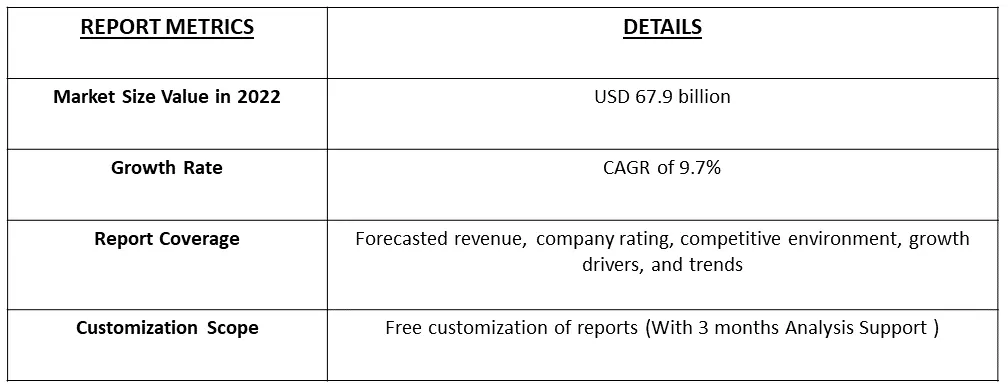The Smart Hospital Market is currently valued at USD 67.9 billion in the year 2022 registering a CAGR of 9.7% over the forecast period, 2023-2030.

Get Complete Analysis Of The Report - Download Free Sample PDF
The Smart Hospital market report provides detailed information regarding several segments of smart hospitals, such as hardware, software, and the solutions component. The report analyzes the smart hospital ecosystem and discusses Electronic Medical Records (EMRs), alarm management, research databases, and clinical decision support systems.
The Smart Hospital Market is expected to witness significant growth over the forecast period due to the modernization of healthcare infrastructure is boosting the demand for smart hospitals and increasing penetration of connected devices and instruments in hospitals.
The rising trend of the Internet of Things (IoT) continues to transform healthcare delivery services at an unprecedented pace. Connected medical devices are increasing patient safety and efficiency. When such technologies are applied to the complete healthcare organization ecosystem, it becomes a "Smart Hospital."
Segmentation:
The Smart Hospital Market is Segmented
By Component :
By Application :
Geography :
The market sizes and forecasts are provided in terms of value in USD billion for all the above segments.

For Detailed Market Segmentation - Download Free Sample PDF
Drivers:
Modernization of Healthcare Infrastructure is Boosting the Demand for Smart Hospitals
Factors such as technological advancements, increased healthcare spending, a sedentary lifestyle, more awareness, and a high acceptance rate of new technologies are driving the growth of the global smart hospital market. The increasing rise in chronic illnesses such as diabetes and cardiovascular disease, particularly in industrialized nations, has dramatically increased the demand for healthcare solutions in recent decades. Furthermore, the recent developments are driving the growth of the studied market. For instance, in July 2022, GE Healthcare inaugurated the company’s first 5G innovation lab. The lab aimed at developing healthcare solutions by employing 5G and other smart solutions, such as artificial intelligence, augmented and virtual reality, and advanced visualization to streamline image transfers and teleradiology. It also enabled the company to foster collaborations with various academia, industry researchers, and startups to co-create future-ready solutions.
Increasing Penetration of Connected Devices and Instruments in Hospitals
Connected medical devices are one of those new medical industries that has consistently grown over the last decade, given its dependency on IoT technologies. For over two decades, consumer-facing healthcare has steadfastly resisted the wave of innovations that have been disrupting industries. It signifies that the industry is ripe for disruption, and technologies like Artificial Intelligence (AI) and Machine Learning (ML) will be vital to unlocking greater connected healthcare possibilities.
Restraints:
High Cost of Medical Connected Systems
Medical IoT developers created an iOS application that visualizes sensor data and alerts hospital staff in emergency cases. To render ECG sensor data in real-time leveraged the OpenGL API and partially shifted the workload to mobile GPU. A similar IoT application costs USD 10,000-15,000. Thus, such high costs of medical-connected instruments are expected to slow down the growth of the studied market.
Segmental Analysis:
EHR Segment is Expected to Witness Significant Growth Over the Forecast Period
EHR is probably the most important software used in hospitals because it allows them to store and update patient data, treatment history, diagnoses, prescriptions, medical records, allergy information, and more. EHR software maintains the continuity of treatment and significantly reduces administrative work. Furthermore, the cost of installation in electronic health records is less in hospitals as compared to ambulatory care centers, which also boosts the market growth. They also help in saving time for large-scale hospitals, which further fuels the market. Furthermore, the high adoption of electronic health records in small and midsized hospitals, due to factors such as ease of deployment, is expected to drive the segment.
Europe Region is Expected to Witness Significant Growth Over the Forecast Period
European countries, such as Germany, the United Kingdom, Sweden, and the Netherlands, have advanced infrastructure to deploy next-generation health informatics applications and build smart hospitals. These countries use AI for smart medical services, and IoT to connect devices to transfer patient data and reduce health risks. With wide-scale involvement for businesses, consumers, and workers, the rapid implementation of Industry 4.0 in the United Kingdom is a revolutionary step for the country, thereby leading to the development of smart hospitals. While several regulatory constraints were posed due to the Brexit scenario, Europe has managed to be one of the top smart device manufacturers. Also, the steady flow of investments into the healthcare sector, primarily due to starting projects previously in the pipeline, is expected to create opportunities for the market studied. Many companies in the region are witnessing the introduction of technologies, such as the Internet of Medical Things (IoMT), which is expected to propel the well-established healthcare industry. For instance, in October 2021, Royal Philips announced that with the release of its new device drivers that enable integration and interoperability, Philips Capsule Medical Device Information Platform (MDIP) exceeded the milestone of integrating more than 1,000 unique medical device models.

Get Complete Analysis Of The Report - Download Free Sample PDF
The Smart Hospital Market is highly fragmented due to the presence of many market players working globally and regionally. Some of the market players working in this market segment are:
Key Players :
Recent Developments:
1. February 2022: GE Healthcare, a subsidiary of General Electric Company, collaborated with AWS to provide AI-enabled diagnostic imaging cloud solutions for healthcare organizations. The company focused on providing better clinical insights and transforming healthcare quality by including accessories, such as sensor readings, genomics, lab tests, etc.
2. January 2022: Francisco partners announced the acquisition of IBM healthcare data and analytics assets. This acquisition provided the company with an enhanced platform for hybrid cloud and AI strategy in the healthcare market.
Q1. What is the current Smart Hospital Market size?
The Smart Hospital Market is currently valued at USD 67.9 billion.
Q2. What is the Growth Rate of the Smart Hospital Market?
The Smart Hospital Market is registering a CAGR of 9.7% over the forecast period.
Q3. Which is the leading Component Segment in the Smart Hospital Market?
EHR is the leading Component Segment in the Smart Hospital Market.
Q4. Which region has the largest share of the Smart Hospital Market.? What are the largest region's market size and growth rate??
European was the largest region in the in 2022. For detailed insights on the largest region's market size and growth rate request a sample here
Data Library Research are conducted by industry experts who offer insight on industry structure, market segmentations technology assessment and competitive landscape (CL), and penetration, as well as on emerging trends. Their analysis is based on primary interviews (~ 80%) and secondary research (~ 20%) as well as years of professional expertise in their respective industries. Adding to this, by analysing historical trends and current market positions, our analysts predict where the market will be headed for the next five years. Furthermore, the varying trends of segment & categories geographically presented are also studied and the estimated based on the primary & secondary research.
In this particular report from the supply side Data Library Research has conducted primary surveys (interviews) with the key level executives (VP, CEO’s, Marketing Director, Business Development Manager and SOFT) of the companies that active & prominent as well as the midsized organization
FIGURE 1: DLR RESEARH PROCESS

Extensive primary research was conducted to gain a deeper insight of the market and industry performance. The analysis is based on both primary and secondary research as well as years of professional expertise in the respective industries.
In addition to analysing current and historical trends, our analysts predict where the market is headed over the next five years.
It varies by segment for these categories geographically presented in the list of market tables. Speaking about this particular report we have conducted primary surveys (interviews) with the key level executives (VP, CEO’s, Marketing Director, Business Development Manager and many more) of the major players active in the market.
Secondary ResearchSecondary research was mainly used to collect and identify information useful for the extensive, technical, market-oriented, and Friend’s study of the Global Extra Neutral Alcohol. It was also used to obtain key information about major players, market classification and segmentation according to the industry trends, geographical markets, and developments related to the market and technology perspectives. For this study, analysts have gathered information from various credible sources, such as annual reports, sec filings, journals, white papers, SOFT presentations, and company web sites.
Market Size EstimationBoth, top-down and bottom-up approaches were used to estimate and validate the size of the Global market and to estimate the size of various other dependent submarkets in the overall Extra Neutral Alcohol. The key players in the market were identified through secondary research and their market contributions in the respective geographies were determined through primary and secondary research.
Forecast Model
